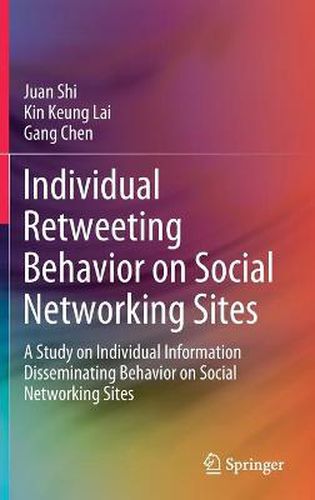Readings Newsletter
Become a Readings Member to make your shopping experience even easier.
Sign in or sign up for free!
You’re not far away from qualifying for FREE standard shipping within Australia
You’ve qualified for FREE standard shipping within Australia
The cart is loading…






This title is printed to order. This book may have been self-published. If so, we cannot guarantee the quality of the content. In the main most books will have gone through the editing process however some may not. We therefore suggest that you be aware of this before ordering this book. If in doubt check either the author or publisher’s details as we are unable to accept any returns unless they are faulty. Please contact us if you have any questions.
This book explores and analyzes influential predictors and the underlying mechanisms of individual content sharing/retweeting behavior on social networking sites (SNS) from an empirical perspective. Since Individual content sharing/ retweeting behavior expedites information dissemination, it is a critical mechanism of information diffusion on Twitter.
Individual sharing/retweeting behavior does not appear to happen randomly. So, what factors lead to individual information dissemination behavior? What are the dominating predictors? How does the recipient make retweeting decisions? How do these influential predictors combine and by what mechanism do they influence an individual’s retweeting decisions? Furthermore, are there any differences in the process of individual retweeting decisions? If so, what causes such differences?
In order to answer these previously unexplored questions and gain a holistic view of individual retweeting behavior, the authors examined people’s retweeting history on Twitter and obtained a real dataset containing more than 60 million Twitter posts. They then employed text mining and natural language processing techniques to extract useful information from social media content, and used various feature selection methods to identify a subset of salient features that have substantial effects on individual retweeting behavior. Lastly, they applied the Elaboration Likelihood Model to build an overarching theoretical framework to reveal the underlying mechanisms of individual retweeting behavior. Given its scope, this book will appeal to researchers interested in investigating information dissemination on social media, as well as to marketers and administrators who plan to use social networking sites as an important avenue for information dissemination.
$9.00 standard shipping within Australia
FREE standard shipping within Australia for orders over $100.00
Express & International shipping calculated at checkout
This title is printed to order. This book may have been self-published. If so, we cannot guarantee the quality of the content. In the main most books will have gone through the editing process however some may not. We therefore suggest that you be aware of this before ordering this book. If in doubt check either the author or publisher’s details as we are unable to accept any returns unless they are faulty. Please contact us if you have any questions.
This book explores and analyzes influential predictors and the underlying mechanisms of individual content sharing/retweeting behavior on social networking sites (SNS) from an empirical perspective. Since Individual content sharing/ retweeting behavior expedites information dissemination, it is a critical mechanism of information diffusion on Twitter.
Individual sharing/retweeting behavior does not appear to happen randomly. So, what factors lead to individual information dissemination behavior? What are the dominating predictors? How does the recipient make retweeting decisions? How do these influential predictors combine and by what mechanism do they influence an individual’s retweeting decisions? Furthermore, are there any differences in the process of individual retweeting decisions? If so, what causes such differences?
In order to answer these previously unexplored questions and gain a holistic view of individual retweeting behavior, the authors examined people’s retweeting history on Twitter and obtained a real dataset containing more than 60 million Twitter posts. They then employed text mining and natural language processing techniques to extract useful information from social media content, and used various feature selection methods to identify a subset of salient features that have substantial effects on individual retweeting behavior. Lastly, they applied the Elaboration Likelihood Model to build an overarching theoretical framework to reveal the underlying mechanisms of individual retweeting behavior. Given its scope, this book will appeal to researchers interested in investigating information dissemination on social media, as well as to marketers and administrators who plan to use social networking sites as an important avenue for information dissemination.